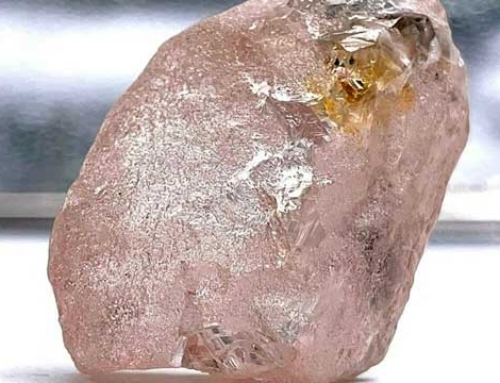Does the natural diamond suffer from a communication deficit? Jean Marc Lieberherr thinks so. This is why this connoisseur of the mining world, having spent several years as Managing Director at Rio Tinto (Anglo-Australian mining group, leading diamond mining company with De Beers and Alrosa) founded the DPA ( Diamond Producers Association) in 2015.
The aim and justification of this association, which has a budget of several million euros, is to get back in touch with the press in order to dissolve the possible misunderstandings that the natural diamond industry raises and to highlight the significant efforts made by the sector in terms of sustainable development and respect for the environment. It is, in summary, figures and powerpoint documents in support, to exalt the aura of the diamond around values calling on trust and integrity.
To put a little transparency in this industry deemed complex, the DPA held a press conference in Paris on Tuesday, November 20th. France is not, far from it, a big consumer of diamonds (1 per cent of world consumption, the main market being the United States) but the brilliance and the antiquity of the French jewelry houses and the excellence of their productions justify, from the point of view of the association, to speak with the French media. The DPA has accepted, without reservation, to answer the many questions raised by journalists, especially those concerning the emergence of synthetic diamond.
Regarding sustainable development, the DPA is clear: “The major groups such as Alrosa, De Beers, Rio Tinto are not content to just work on the exploration, extraction and marketing of the stones. They also play a leading role in establishing procedures not only to minimize the impact of mining activities on nature, but also to encourage economic growth in producing countries.” Some concrete examples. By stimulating the creation of jobs, promoting the building of hospitals, schools or road networks, by investing in the fight against AIDS, by developing large-scale social programs.
The association then sweeps away what it calls untruths: “No, the diamond industry is not the fruit of a monopoly, no, the diamond industry is not a world run by men only, nor does the diamond industry thrive on conflict but it flourishes on the contrary, more than ever, from the mine to the store, on personal and unique stories on social and cultural achievements.”
Natural Diamond: gain the trust of a new generation of consumers
Finally comes the nerve of war: responsibility. The question is vast, the program ambitious. However, we must applaud the efforts that major players in the sector seem to want to put in place to win the trust of a new generation of consumers who are eager to buy products that comply with certain ethical concepts. The ultimate goal is, of course, to succeed in the near future with the establishment of a universal supply chain and transparency.
To convince us, the association sums up the figures: “The artisanal diamond sector employs 1.5 million people worldwide. It represents an important source of income in the producing countries of Russia, Botswana, Namibia, Angola, South Africa, Canada, Congo, Australia, knowing that the countries of the Sub-Saharan Africa provides nearly half of the world’s output of rough diamonds in value. Some examples: In Bostwana, the diamond industry has made a significant contribution to the country’s economic growth, which is now enjoying the highest rate of development in African countries. Another example: Alrosa employees’ salaries are twice as high as the average salary in Yakutia and three times higher than the average wage in Russia. The majority of workers are also members of the specialized union that protects their interests. Alrosa pays more than $ 1 billion annually in taxes and dividends to Yakutia, which represents nearly 40 percent of the region’s budget.”
The diamond industry, we learn from the DPA, also develops large-scale social programs. “In 2016 alone, Alrosa has provided more than $ 180 million in social investments, or about 3 percent of its revenues.” Social projects that really benefit the people. Thus, at the end of last year, Alrosa started a vast program of free health screening for workers. The company is also responsible for providing additional pensions, health care, mortgages and housing assistance, as well as organizing sporting and cultural events. The De Beers Group stimulates the creation of hospitals, schools, community services and road networks in producing countries, such as Botswana. The group covers all the medical expenses of its employees and their spouses.
Finally, there is the section on synthetic diamond. In 1971, General Electric succeeded for the first time in developing the a gem-quality synthetic diamond in the laboratory. With machines running for a whole week, stones up to 1 carat were produced. Element Six is now one of the largest synthetic diamond companies in the world and there are now several methods to make diamonds in the laboratory: the two main ones are the high pressure and high temperature (HPHT) method or the deposit chemical vapor phase (CVD). With the naked eye, the two stones are alike. It should be noted, however, that certified laboratories know how to distinguish a natural stone from a synthetic stone, thanks to tiny peculiarities related to inclusions, aggregation of nitrogen and growth form.
The question that irritates: is synthetic diamond an ecological alternative to natural diamond? For the DPA, the answer is clearly no. On the one hand, because only the diamond industry contributes to the livelihood of many millions of people around the world, working actively with NGOs to establish transparent trade routes, representing a significant source of income for the population, for the local people suffering from poverty. Secondly – and this is the key argument of the DPA’s demonstration – because a CVD diamond of a carat produced in China or Singapore emits 40 per cent more CO2 than a natural diamond. Not to mention the fact that synthetic diamonds have no socio-economic impact beyond their private shareholders. A very convincing demonstration in favor of the natural diamond.







